Hailstorms occur during thunderstorms when powerful updrafts carry water droplets above the freezing level in cumulonimbus clouds. These droplets freeze into small hailstones, accumulating layers of clear and cloudy ice as they travel through different temperature zones. The size of hailstones correlates directly with storm intensity and updraft strength. When too heavy for the updraft to support, hailstones fall to earth. Understanding the complex formation process reveals critical factors in predicting and preparing for these severe weather events.
Key Takeaways
- Hailstorms occur when thunderstorm updrafts carry water droplets above the freezing level, where they form into balls of ice.
- Strong upward air currents repeatedly lift frozen droplets through layers of supercooled water, creating multiple ice layers.
- Hailstones grow larger through wet and dry growth processes until they become too heavy for updrafts to support.
- Formation requires specific conditions: abundant moisture, unstable air temperatures, strong wind shear, and cumulonimbus cloud development.
- Hailstones range from pea-sized to massive spheroids exceeding 15 cm, with size directly related to storm intensity.
Understanding the Nature of Hailstorms
The formation of hailstorms represents one of nature's most dynamic weather phenomena, occurring when powerful thunderstorm updrafts carry water droplets above the freezing level in the atmosphere.
During this process, the water droplets freeze and develop into hailstones through both wet and dry growth processes. The ultimate size of these frozen particles directly correlates with storm intensity and updraft strength.
As hailstones travel through varying temperature zones within the thunderstorm, they accumulate distinct layers of clear and cloudy ice, reflecting the different conditions encountered during their formation.
This layering process continues until the hailstones become too heavy for the updraft to sustain them, at which point gravity pulls them earthward.
The resulting precipitation can create hail swaths ranging from small areas to extensive paths up to 10 miles wide and 100 miles long, with individual hailstones capable of reaching speeds up to 120 mph during their descent.
The Complex Process of Hail Formation
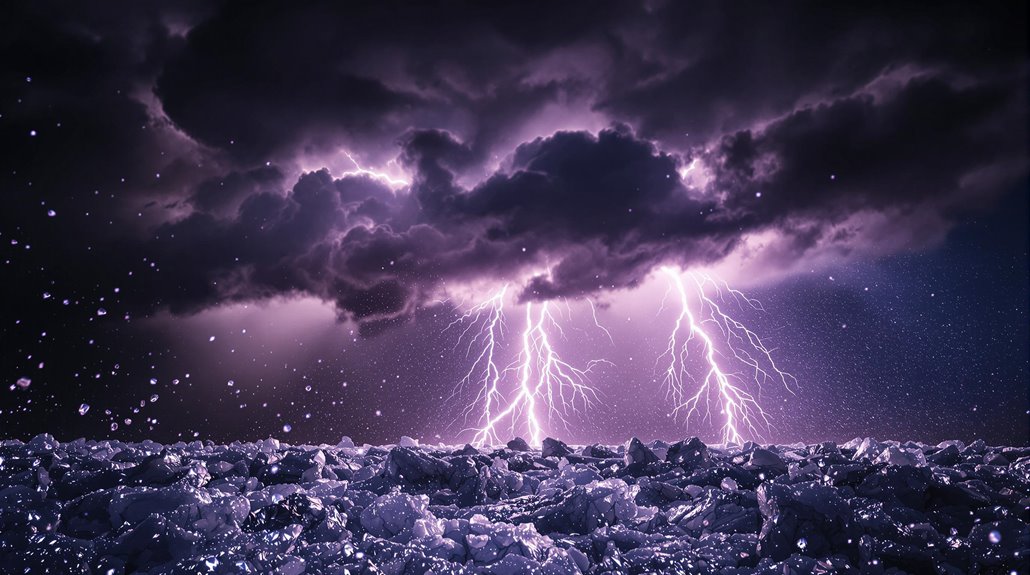
Deep within powerful thunderstorm clouds, hail formation begins when strong updrafts propel water droplets above the freezing level, where they encounter supercooled water and ice nuclei.
The freezing process initiates as these droplets collide and freeze, forming the core of what will become a hailstone structure.
As updrafts continue to lift these developing hailstones, they accumulate additional layers through both wet and dry growth phases.
Wet growth produces clear ice layers, while dry growth creates opaque layers due to trapped air bubbles.
The strength of the updraft, which can reach speeds of 110 mph, determines how long the hailstones remain suspended and continue growing.
When hailstones become too heavy for the updraft to support, they fall to the ground.
This process requires specific atmospheric conditions, including unstable air, strong vertical motion, and a sufficient supply of supercooled water droplets.
The resulting hailstones can vary dramatically in size, from quarter-inch pellets to specimens exceeding four inches in diameter.
Key Ingredients for Severe Hailstorms
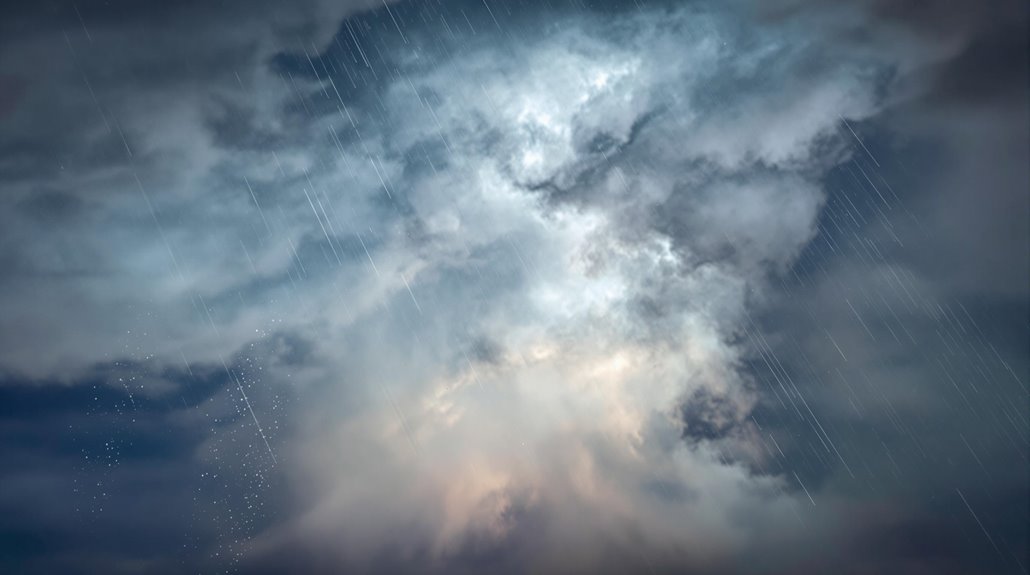
Three essential atmospheric conditions must align to produce severe hailstorms: abundant low-level moisture, significant temperature variations with height, and strong wind shear.
These hail formation factors create an environment where powerful thunderstorms can develop and sustain the production of hailstones. When these primary conditions combine with favorable geographic and meteorological elements, the likelihood of severe hailstorms increases substantially.
Critical factors that intensify hailstorm conditions include:
- Presence of cumulonimbus clouds with significant vertical development
- Strong updrafts capable of suspending growing hailstones
- High liquid water content within the cloud system
- Elevation profiles where the freezing level remains below 11,000 feet
The interaction of these elements determines both the frequency and severity of hailstorms.
Continental interiors, particularly in mid-latitude regions, experience more frequent hailstorms due to the ideal combination of warm surface temperatures and cold upper-level conditions, creating the perfect environment for hail development.
Types and Sizes of Hailstones
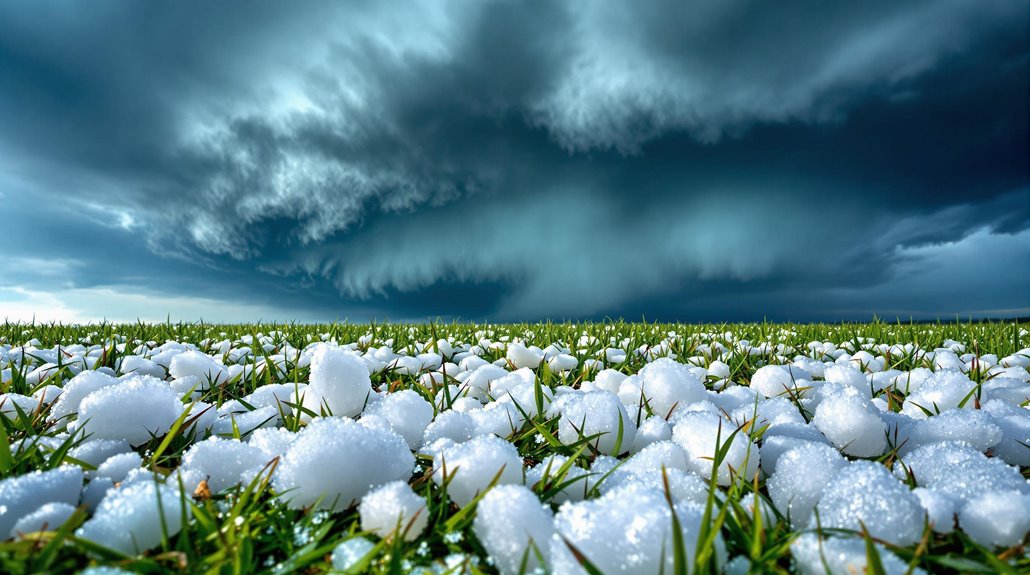
Powerful forces within thunderstorm updrafts create diverse types of hailstones, ranging from small pea-sized particles to massive spheroids exceeding 15 centimeters in diameter. These frozen precipitation forms exhibit distinct hailstone characteristics, including layered structures composed of alternating clear and opaque ice bands, formed through wet and dry growth processes respectively.
Meteorologists employ a standardized hailstone classification system based on diameter measurements. The smallest category begins with pea-sized hail (under 0.64 cm), progressing through marble-sized (0.64-1.27 cm), quarter-sized (2.54 cm), golf ball-sized (4.45 cm), and tennis ball-sized (6.35 cm) classifications.
Each size category correlates with specific damage potential, from minimal plant damage caused by smaller hailstones to catastrophic structural damage from larger specimens. The irregular shapes and varying textures of hailstones result from their complex formation within cumulonimbus clouds, where they undergo multiple cycles of ascent and descent in strong updrafts.
Impact and Safety During Hailstorms

Hailstorms inflict substantial economic and infrastructural damage across the United States, with annual losses averaging $15 billion from impacts to residential structures, vehicles, and agricultural assets.
Population growth in hail-prone regions, particularly Denver and Dallas-Fort Worth, has intensified the economic impact, with 2017 marking the costliest year at $22 billion in damages.
Similar to hurricane preparedness protocols, implementing proper safety measures during hailstorms is vital for minimizing risk:
- Seek immediate shelter in sturdy buildings, avoiding windows and natural shelters like trees.
- Protect vehicles by relocating to covered areas or using specialized hail protection equipment.
- Monitor weather forecasts and plan activities accordingly.
- Document all damage thoroughly for insurance and storm recovery purposes.
The Phoenix hailstorm of 2010 demonstrates the potential severity of these weather events, causing $3.2 billion in damages and highlighting the importance of preparedness measures, including impact-resistant windows and regular roof maintenance.
Regular roof maintenance can help homeowners qualify for insurance premium savings and better protect their homes during severe weather events.
The Benefits Of Consulting A Public Adjuster
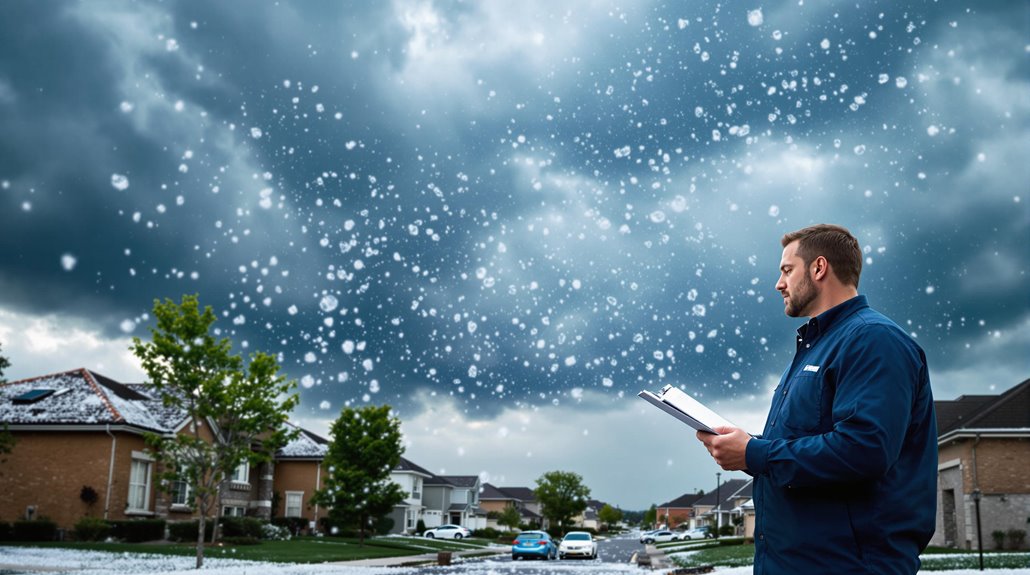
Following severe hailstorm damage, property owners can benefit considerably from consulting public adjusters who possess specialized expertise in insurance claims and damage assessment protocols.
These licensed professionals provide objective evaluations of hail-impacted structures and assets, while managing the intricate documentation and negotiation processes with insurance carriers.
Their involvement often results in more thorough claim settlements, as they understand the technical aspects of hail damage and can identify both obvious and latent structural impacts that might otherwise go unnoticed.
Studies demonstrate that claims handled by public adjuster representation achieve up to 800% higher settlements compared to those without professional assistance.
Expertise In Insurance Claims
A public adjuster's expertise can be invaluable when dealing with hailstorm-related insurance claims, particularly given the complex nature of weather-induced property damage. Their thorough understanding of insurance policies and claims advocacy enables them to accurately assess and document hail damage, ensuring all affected areas are properly evaluated.
During settlement negotiation, public adjusters utilize their specialized knowledge to:
- Analyze weather data and correlate it with property damage patterns
- Document microscopic indentations that might be overlooked in standard assessments
- Navigate complex policy clauses specific to severe weather events
- Calculate depreciation factors based on pre-storm property conditions
Their technical expertise helps policyholders receive fair compensation for both visible and latent hail damage, while ensuring compliance with local insurance regulations and documentation requirements. With a typical contingency fee structure of 5-20% of the final claim amount, public adjusters offer cost-effective representation compared to legal alternatives.
Objective Damage Assessment
The process of objectively evaluating hail damage requires systematic evaluation protocols and specialized expertise to secure accurate documentation of property impacts.
Through extensive damage documentation, including photographic evidence and detailed inspection records, assessors can accurately determine the full scope of structural compromise.
Independent evaluations conducted by public adjusters provide unbiased assessments that serve property owners' interests exclusively.
These professionals utilize advanced technologies, such as HailSens IoT sensors, to collect real-time data on hailstone size and kinetic energy, enabling precise damage verification.
This technological integration, combined with local expertise in construction costs and zoning regulations, guarantees a thorough understanding of both visible and concealed damage.
Such objective assessments prove instrumental in securing appropriate settlements and maneuvering the complexities of insurance claims processes.
While standard claims adjusters prioritize insurer interests, public adjusters negotiate exclusively on behalf of policyholders to maximize legitimate damage compensation.
Streamlined Claim Process
Public adjusters greatly streamline the hail damage claims process through systematic handling of documentation, communication, and negotiation protocols. Their expertise in managing insurance claims markedly enhances claim efficiency while promoting stress reduction for affected property owners.
By implementing digital workflows and leveraging technological solutions, they optimize the entire claims lifecycle from initial documentation to final settlement.
Key benefits of public adjuster services include:
- Professional oversight of all claim-related communications and paperwork
- Expert interpretation of insurance policies and regulatory requirements
- Strategic negotiation with insurance carriers to maximize settlements
- Extensive documentation of hail damage using standardized protocols
Their systematic approach guarantees thorough assessment of hail-induced property damage while maintaining strict adherence to insurance industry standards and regulatory requirements, ultimately expediting the claims resolution process.
Working on a 24-hour response commitment, public adjusters ensure consistent and timely communication throughout the entire claims process.
Higher Claim Payouts & Settlements
When engaging professional claims representation, property owners typically secure settlements that average 574% higher than those obtained without expert assistance.
Public adjusters employ advanced claim strategies that include thorough damage assessments, detailed documentation, and expert negotiation tactics with insurance carriers.
These professionals leverage their expertise in policy interpretation and construction estimation to identify both visible and concealed damage patterns resulting from hailstorm impacts.
Their thorough understanding of local building codes, material costs, and labor rates enables precise damage valuations.
Through systematic documentation and strategic negotiations, adjusters guarantee policyholders receive settlements that accurately reflect the full scope of hail-related repairs needed, including often-overlooked damage to HVAC systems, windows, and operational equipment.
This methodical approach consistently yields considerably higher compensation compared to initial insurance company offers.
About The Public Claims Adjusters Network (PCAN)
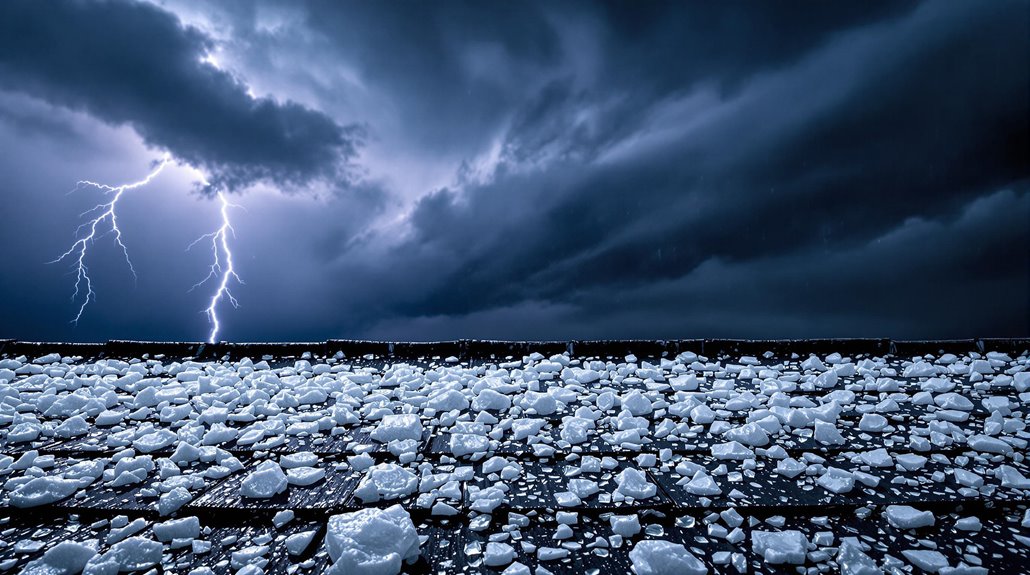
Professional networks of public claims adjusters form an essential support system for policyholders facing property damage from severe weather events like hailstorms. These networks, operating across all 50 states and internationally, provide specialized claim advocacy through independent professionals who understand complex insurance policies and damage assessment protocols.
Public adjuster roles encompass thorough claim management, from initial documentation to final settlement negotiations.
Key services provided by public claims adjuster networks include:
- Technical analysis of hailstorm damage patterns and structural impact assessment
- Documentation of meteorological conditions and their relationship to property damage
- Evaluation of business interruption costs and long-term property devaluation
- Strategic communication management between contractors, witnesses, and insurance carriers
These networks leverage their extensive expertise to guarantee accurate damage assessment and fair compensation for weather-related claims.
Their systematic approach includes detailed policy analysis, damage documentation, and strategic claim presentation, maximizing the probability of favorable settlements for affected property owners.
Frequently Asked Questions
Can Hailstorms Occur During Winter Months?
While winter hail is less frequent due to seasonal patterns, it can occur, particularly in the Southeast United States, when specific atmospheric conditions create strong updrafts and temperature variations necessary for formation.
What Is the Longest Recorded Hailstorm in History?
Historical records indicate a week-long storm system in Minneapolis during June 2017 stands as the longest documented hailstorm event, affecting multiple regions from Minnesota to Texas to Virginia.
Do Hailstorms Always Produce Thunder and Lightning?
With over 90% of severe hailstorms exhibiting electrical activity, the thunder relationship and lightning frequency are intrinsically linked to hail formation through strong updrafts within cumulonimbus clouds' charging zones.
Which Country Experiences the Most Frequent Hailstorms Annually?
Based on hail frequency data, the United States experiences the most hailstorms annually, particularly in "Hail Alley" where hail geography and atmospheric conditions create ideal environments across Nebraska, Colorado, and Wyoming.
Can Hailstones Contain Foreign Objects Inside Them?
Foreign object analysis confirms hailstones can incorporate various materials during formation, including dust, dirt, and debris, which serve as nucleation sites within their layered composition while accumulating supercooled water droplets.
References
- https://www.battlbox.com/blogs/outdoors/what-is-hailstorm-understanding-the-phenomenon-and-its-impact
- https://www.battlbox.com/blogs/outdoors/how-do-hailstorms-form-a-comprehensive-exploration-of-hail-formation
- https://tyscaletta.weebly.com/18-19-7th-grade-science-nscd.html
- https://study.com/learn/lesson/what-is-hail.html
- https://americanroofingandexteriors.com/what-causes-hail-the-science-behind-hail-formation/
- https://www.onslowcountync.gov/618/Thunderstorms-Hail
- https://gpm.nasa.gov/resources/faq/how-does-hail-form
- https://www.nssl.noaa.gov/education/svrwx101/hail/
- https://www.earthnetworks.com/hail/
- https://www.youtube.com/watch?v=HfEOw1A9_yU








